► Hyundai’s latest family SUV unveiled
► Choice of hybrid and electric powertrain
► Now with N Line trim
Hyundai has revealed a new N Line version of its electric Kona crossover. Significantly, Hyundai’s best-selling EV (that’s over the Ioniq 5 and Ioniq 6) is the first to get the mildly spicy N Line treatment. Here’s what you need to know about Hyundai’s latest sport-centric move.
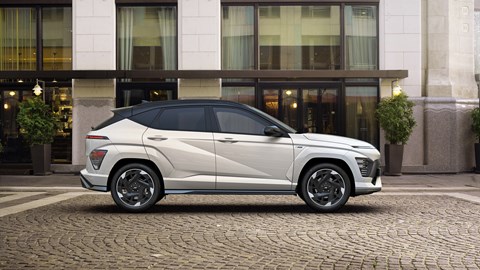
What’s new?
The Kona Electric N Line looks just as futuristic as the stock car, but now adds a dash of aggression to the mix. Bumpers on the front and rear have been tidied up with bolder features, and they’re joined by a pair of stylish new side skirts. The whole thing rolls on N Line-only 19-inch wheels, and the sportier Kona Electric is adorned with exclusive N Line badging.
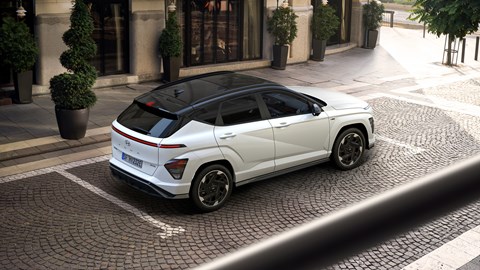
Inside, the mildly spicy Kona also gets sports seats with red contrasting stitching, and other red details on the dashboard and wheel.
How much?
UK customers will be able to choose from an N Line or N Line S trim, with prices starting at £40,395 for the N Line 65kWh. The N Line S begins at £43,095 but adds extra mod cons such as Alcantara and leather trimmed seats and a Bose premium sound system inside.
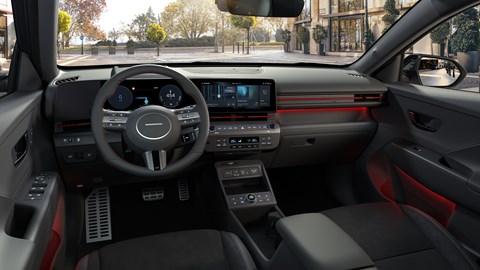
The N Line S also gets LED DRL’s as standard. Although the N Line is featured on the Electric first, it’ll be available on all powertrains, including ICE and hybrid.
Production is due to begin next month, with deliveries starting in spring.

Read everything else about the standard car below.
Everything you need to know
This is the all-new Hyundai Kona. It’s the second-generation version of the company’s popular family SUV, which is due to hit the UK market in August 2023. It’ll compete against a broad range of rivals, including the Ford Puma, Vauxhall Mokka, Peugeot 2008 and MG ZS.
On the surface, the new Kona looks like an evolution of the previous model, but Hyundai assures us it’s a stark departure. It’ll be offered with a choice of hybrid and electric powertrains but, unlike the old car, the firm’s engineers designed the EV model first then made the hybrid variants fit its profile.
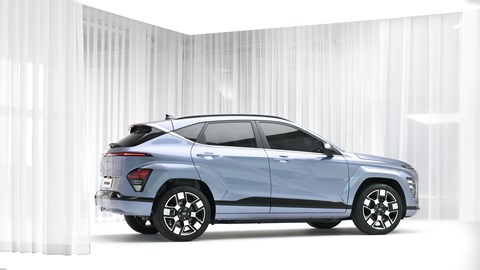
This change is due to Hyundai’s expected sales split during the Kona’s life cycle. Currently, EVs account for around 40% of the brand’s sales, but Hyundai Europe’s president and CEO, Michael Cole, told us that figure will soon swell past 50%. So, it’s important Hyundai has a strong electric vehicle in the volume-driven B-segment to complement the larger Ioniq 5 hatchback and the upcoming Ioniq 7 SUV. We’ve spent some time in the studio with the car – here’s what we learned.
How much will it cost?
The pricing structure for the EV-variant of the Kona will be as follows.
| Description | Fuel Type | Insurance Group
(1-50) | VED Band | VED Cost | Recommended
On The Road Price | P11D Value | BIK Tax % |
| Advance 48kWh | BEV | TBC | A | 0 | £34,995.00 | £34,940.00 | 2 |
| Advance 65kWh | BEV | TBC | A | 0 | £38,595.00 | £38,540.00 | 2 |
| N Line 65kWh | BEV | TBC | A | 0 | £40,395.00 | £40,340.00 | 2 |
| N Line S 65kWh | BEV | TBC | A | 0 | £43,095.00 | £43,040.00 | 2 |
| Ultimate 65kWh | BEV | TBC | A | 0 | £43,095.00 | £43,040.00 | 2 |
Design and aerodynamics
Cars are getting bigger – and the new Kona is no exception. It measures 4355mm long and 1825mm wide, making it 150mm longer and 25mm wider than the previous model. However, Hyundai assures us this isn’t just size for the sake of size.
The company has tried to make the new car more practical than the old one. So, its wheelbase has increased by 60mm and the front seat backs are 30% slimmer than the previous car’s, which has liberated a little more legroom for those in the rear. The boot opening is also wider and lower, while boot capacity has shot up from 374 litres to 466 litres.
The Kona’s styling is equally functional. Ssangyup Lee, Hyundai’s global head of design, explained how the car’s front end was designed to produce the best results in wind tunnel testing. That’s particularly important for the electric variants, because the more aerodynamic an EV is, the more miles it can eke out of its battery pack.
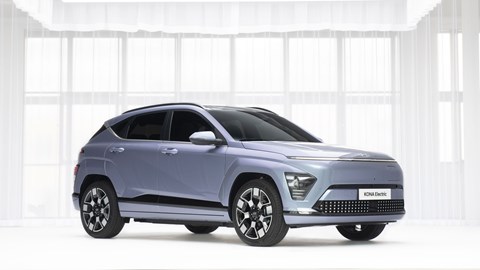
Ssangyup’s efforts produced a car with a drag co-efficient of 0.27. That means this tall-riding SUV is as aerodynamic as a Toyota GT86. That’s impressive, but it took a lot of clever engineering to arrive at that figure. The front bumper, for example, was designed to wrap around the front of the car like a rocket’s nose cone.
The panel joints are pushed back along the wings, meaning they don’t take the full force of the air rushing over the front of the car, which create less turbulence. There’s also an active shutter in the front grille that blocks the opening when it isn’t required for cooling.
Interior and practicality
Hyundai has moved the Kona’s interior design on, too. Sangyup said: ‘The whole theme about this interior is the furniture design. Car interiors are becoming more of a living space than a driving space. So why can’t the interior be more like functional furniture?’
There are loads of clever features designed to make the cabin practical and functional. For example, the centre was made large enough to swallow a handbag and there’s a household plug socket in the rear, so you can charge your laptop while you work on the go.

Lee has also tried to buck the current trends of automotive design in the name of practicality. He used the line between the Kona’s dashboard and the door card as an example.
‘A lot of cars have a horizontal line trying to connect with the door and the pillar all the way around. But that’s never going to work because the door panel is mounted on the door and the instrument panel is mounted on the firewall – and it’s impossible to make that line match perfectly.
Instead, we totally separate them like your own house. The door is a door, the wall is a wall and the window is a window, instead of tying everything together.
‘To make that line match up, we always pull the instrument panel backwards [into the cabin]. For the Kona, we are pushing the instrument panel forwards. So, you don’t have a lot of dents sticking out, which also [makes it easier] to get in and out of the car.’

The new Kona’s infotainment system is a whopper. The most expensive models feature a pair of 12.3-inch screens, complete with Hyundai’s Connected Car Navigation Cockpit and over-the-air updates. Eventually (and Cole stresses that this isn’t happening on the Kona yet) this tech could allow Hyundai to launch a subscription-based service for items like its heated seats and wheel.
Platform and powertrains
Hyundai built the Kona on the same K3 platform found under the latest Kia Niro. As such, you’d expect the two cars would share their electric powertrains – but you’d be wrong. The flagship Kona has a more powerful 214bhp electric motor and a bigger 65.4kWh battery than the equivalent Niro.
Hyundai hasn’t yet pushed the Kona through WLTP homologation, but it reckons its extra 0.6kWh of battery capacity and its clever aero package are enough to bump up its maximum range to 304 miles. That’s 19 miles more than the Kia.
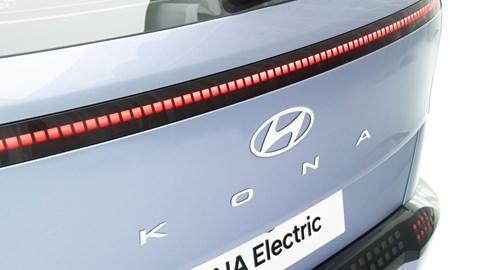
There will also be a less powerful (and cheaper) version of the Kona Electric with a 48.4kWh battery, a 154bhp electric motor and a range of 212 miles. It seems a little odd considering Kia didn’t bother with the new Niro, but European CEO Michael Cole seems confident in the decision.
He said: ‘I think the current model Kona small battery is about 10% of sales. So, I think the small battery still has a market – and you’re looking at, you know, obviously giving that entry point.’
Despite the Kona’s electric-first approach, Cole also told us that Hyundai won’t ditch combustion power completely. As before, it’ll be offered with a range of mild and full hybrid powertrains, all based on the Hyundai Group’s 1.6-litre ‘Smartstream’ petrol engine.
‘Hybrid is also growing,’ Cole explained. ‘Pure internal combustion engines are gradually diminishing, but I still think that, for the European situation, hybrid will probably still be around 25, maybe even 30% [of Kona sales].’
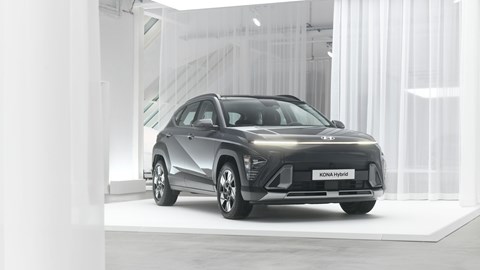
Interestingly, Cole also told us that plug-in hybrid power ‘was never a consideration’ for the Kona, despite the fact Kia offers the technology on the latest Niro. ‘It wasn’t part of our plan,’ he said. ‘We always had it as being internal combustion, hybrid and EV. We didn’t see the plug-in as being so important in that segment.
‘What’s also happening – and it varies by market – is what we’re seeing now in Germany. The government support they had there for plug-in, there is no support anymore. Still, benefit-in-kind of course, because you’ve got low CO2, there’s still some advantage, but the plug-in hybrid sales are slowing down.’
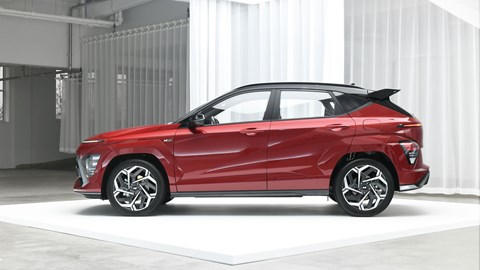
First impression
We only spent a few hours with the car, but we can already tell it’s more practical than the old model. Its boot can now compete with the best-in-class and there’s way more space in the rear, especially in the electric models as they have a completely flat floor.
If we had to make a complaint about the cabin, it’s that the C-pillar slopes down quite sharply. It looks great from the outside and it makes the rear of the car feel very snug, but you need to be careful not to headbutt it when exiting the car because it’s right next to your temple.
Material quality has taken a very noticeable step up. The infotainment system is vastly improved over the previous car and the stuff you regularly interact with (like the steering wheel, switchgear and door handles) all feel solid.
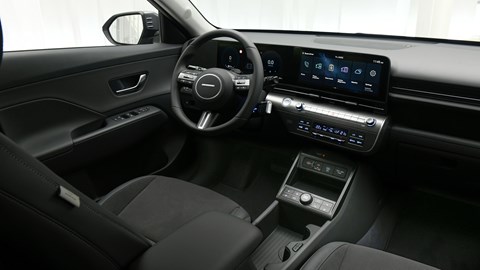
Go digging under the dashboard and you’ll find where Hyundai has cut corners, though. The release handle for the bonnet feels a little flimsy, for example – and you’ll be using it much more often than you did in the old car because that’s where the EV’s charging cables are stored now.
We’re looking forward to getting the Kona on UK roads. We’re particularly curious to find out whether the electric model really can deliver the range boost Hyundai claims over the Kia Niro EV.